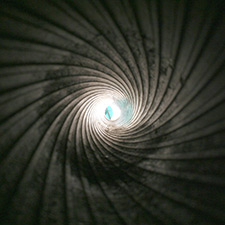- 01: Introduction
- 02: History
- 03: Propellants, Firearms, and Ammunition Development
- 04: Modern Firearms Manufacture
- 05: Small Arms Ammunition
- 06: Evidence Handling Procedures
- 07: Equipment and Instrumentation
- 08: Examination of Firearms
- 09: Cartridge and Shotshell Examination
- 10: Characterization and Evaluation of Fired Projectiles
- 11: Bullet Comparison and Identification
- 12: Gunshot Residue and Distance Determination
- 13: Toolmark Identification
- 14: Communicating Results
- Resources


Rifling
Home > Modern Firearms Manufacture > Rifled Barrels > Rifling

Inside of the rifled barrel of
a French 75 mm gun of WWI
Equipping the barrel with the spiral grooves that spin-stabilize a bullet is the essential operation that defines an entire category of firearms.
There are four ways to produce the grooves:
- Cut rifling
- Single-point rifling
- Broached rifling
- Button-swaged rifling
- Forged rifling
- Electron discharge machining (EDM)
Electrochemical Rifling
In a process that eliminates the conventional machining of metal, rifling is formed by wet-etching the interior of a barrel under an electric current. The metal inside the barrel is actually eaten away or dissolved to create grooves in the barrel. An electrode (cathode) that has metal strips in the shape of the rifling is placed in the barrel (anode) and the the assembly is submerged in a salt solution. An electric current is applied and the electrode is moved down the length of the barrel and twisted to create the spiral shaped grooves. As the current travels from the barrel to the electrode, metal is removed by electrolysis, thus forming the grooves in the barrel. This process creates the rifling in the barrel very quickly and does not require consumable tooling.
Each rifling method has unique features, and the method of rifling can have an important influence on the firearm examiner as he considers a bullet comparison.




